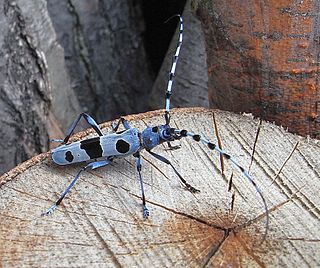
Antennae, sometimes referred to as "feelers", are paired appendages used for sensing in arthropods.

Earwigs make up the insect order Dermaptera. With about 2,000 species in 12 families, they are one of the smaller insect orders. Earwigs have characteristic cerci, a pair of forcep-like pincers on their abdomen, and membranous wings folded underneath short, rarely used forewings, hence the scientific order name, "skin wings". Some groups are tiny parasites on mammals and lack the typical pincers. Earwigs are found on all continents except Antarctica.

The insects of the beetle family Chrysomelidae are commonly known as leaf beetles, and include over 37,000 species in more than 2,500 genera, making up one of the largest and most commonly encountered of all beetle families. Numerous subfamilies are recognized, but the precise taxonomy and systematics are likely to change with ongoing research.
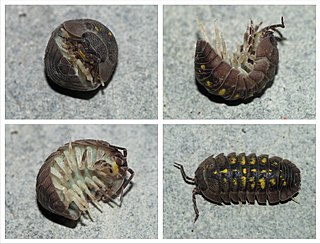
Armadillidiidae is a family of woodlice, a terrestrial crustacean group in the order Isopoda. Unlike members of some other woodlice families, members of this family can roll into a ball, an ability they share with the outwardly similar but unrelated pill millipedes and other animals. This ability gives woodlice in this family their common names of pill bugs or roly polies. Other common names include slaters,potato bugs, butchy boys and doodle bugs. Most species are native to the Mediterranean Basin, while a few species have wider European distributions. The best-known species, Armadillidium vulgare, was introduced to New England in the early 19th century and has become widespread throughout North America.

The Agromyzidae are a family of flies, commonly referred to as the leaf-miner flies for the feeding habits of their larvae, most of which are leaf miners on various plants. It includes roughly 2,500 species, they are small, some with wing length of 1 mm. The maximum size is 6.5 mm. Most species are in the range of 2 to 3 mm.

Troilus luridus, also known as the bronze shieldbug, is a species of shield bug found in Europe. It was first described by the Danish zoologist Johan Christian Fabricius in 1775. Shieldbugs are generally phytophagous and some, including Troilus luridus, are also carnivorous and will eat the larvae of beetles, lepidoptera and sawflies.
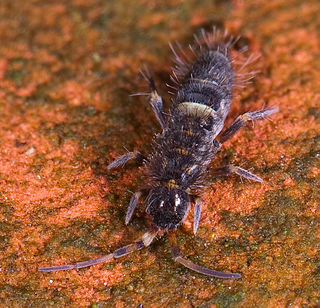
Orchesella cincta is a species of springtail present in North America and Europe. They average 4 millimetres (0.16 in) in length, which is extremely large as most springtails don’t grow past 1 millimetre. The specific name cincta means "belted" and refers to the distinctive colouration of the third abdominal segment.
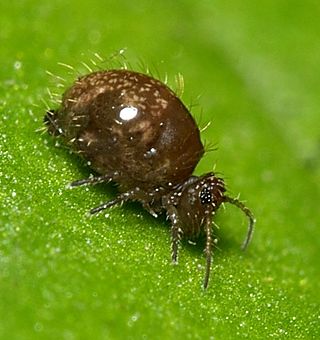
Allacma fusca is a species of springtail. This species is endemic to western areas of Continental Europe and the British Isles, where it lives in the surface layers of the soil in moist habitats such as among leaf litter.

Stigmella ulmivora is a moth of the family Nepticulidae. It is found in all of Europe, except the Balkan Peninsula.
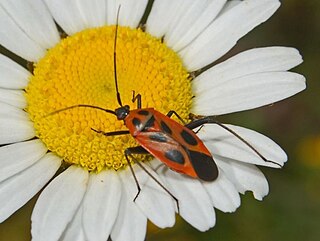
Calocoris nemoralis is a species of true bugs belonging to the family Miridae or jumping tree bugs, subfamily Mirinae.

Deraeocoris schach is a species of plant bugs belonging to the family Miridae, subfamily Deraeocorinae.

Deraeocoris ruberis a species of bug in the Miridae family.

Harpocera thoracica is a species of bugs from Miridae family.

Heterotoma planicornis is a species of bug from Miridae family.

Closterotomus biclavatus is a plant bug belonging to the family Miridae, subfamily Mirinae. The species was first described by Gottlieb August Wilhelm Herrich-Schäffer in 1835.
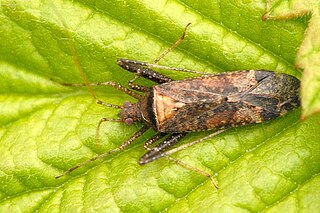
Phytocoris ulmi is a species of plant bugs belonging to the family Miridae, subfamily Mirinae.

Closterotomus norvegicus is a species of bugs belonging to the family Miridae, subfamily Mirinae. It can be found feeding on nettle, clover, and cannabis, as well as Compositae, potatoes, carrots and chrysanthemums. They prefer to feed on the flowers, buds and unripe fruit. The species occurs in the Palearctic-British Isles and east across continental Europe to Siberia. It also occurs in the Nearctic as an adventive species. In 1997 it was moved from the genus Calocoris to its current name.

Orthonotus rufifrons is a species of plant bugs belonging to the family Miridae.

Plagiognathus arbustorum is a species of insects in the family Miridae, the plant bugs.
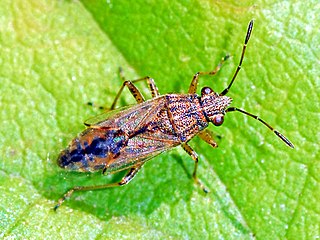
Nysius graminicola is a species of seed bug in the subfamily Orsillinae and in the family Lygaeidae.




















